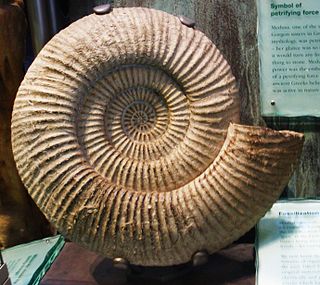Related Research Articles
Aegoceras is an evolutionary wound ammonite, with wide spaced ribs, from the Early Jurassic (England) included in the Liparoceratidae and superfamily Eoderoceratidae. Related genera are Leparoceras and Beaniceras.
Axonoceras is a genus in the ammonitid family Nostoceratidae proposed by Stephenson in 1941, for "slender shells coiled in a plane with numerous closely spaced ribs and two rows of ventral nodes'...The shells may be closely coiled, though not involute, but most... are more or less loosely and irregularly coiled". Shells may be coplanar or coiled in a low flat spiral with the early whorls in contact, later whorls free.

Parapuzosia is an extinct genus of desmoceratid ammonites from the Cenomanian to the Campanian of Africa, Europe, and North America. They are typically very large ammonites, reaching diameters of 60 cm (2.0 ft) or more, with the largest species measuring around 2 m (6.6 ft). It possesses a moderately involute shell with flat or slightly rounded sides. Distinct primary and secondary ribbing can be observed in the inner whorls.
Bradfordia is a moderately involute to involute genus included in the ammonoid cephalopod family Oppeliidae, coiled so that the outer whorl encloses most, or much, of the previous, but with a small umbilicus exposing inner whorls. The shell is compressed, whorl height much greater than width, extending well out from the contact with the adjacent inner whorl. Outer flanks are finely ribbed and the rounded venter is smooth.
Eudmetoceras is an extinct genus from a well-known class of fossil cephalopods, the ammonites. It lived during the Jurassic Period, which lasted from 171.6 to 168.4 million years ago.
Euaptetoceras is an evolute hildoceratoid ammonite from the lower Middle Jurassic, included in the family Hammatoceratidae and the subfamility Hammatoceratinae. The genus may be a junior synonym for Eudmetoceras of Buckman, 1920.
Ermoceras is a genus of ammonite belonging to the Thomboceratidae family of the Middle Jurassic found in deposites of central Arabia, Sinai, and Algeria with strong primary and secondary ribs and a single row of lateral tubercles; described as having a deep ventral groove
Epistrenoceras is an extinct genus from a well-known class of fossil cephalopods, the ammonites. It lived during the Bajocian to the Bathonian.
Eocephalites is an extinct genus from a well-known class of fossil cephalopods, the ammonites. It lived during the Bajocian.
Emileia is an extinct genus from a well-known class of fossil cephalopods, the ammonites, that lived during the early part of the Bajocian.

Durotrigensia is a genus of ammonites (Ammonitida) in the perisphinctoid family Parkinsoniidae.

Nostoceras is an extinct genus of ammonites. The etymology of the name Nostoceras comes from "nostos" meaning return and "ceros" meaning horn, named as such by Alpheus Hyatt because it bends back on itself.

Promicroceras is an extinct ammonite genus from the upper Sinemurian of Europe, named by Leonard Spath in 1925. Promicroceras is included in the family Eoderoceratidae, which is part of the ammonitid superfamily Eoderoceratoidea.

Psiloceras is an extinct genus of ammonite. Psiloceras is among the earliest known Jurassic ammonites, and the appearance of the earliest Psiloceras species form the definition for the base of the Jurassic. Unlike most earlier ammonites, which had complex shell shapes and ornamentation, Psiloceras had a smooth shell.
Aaglacrinus is an extinct genus of crinoidea in the Cladia order. It has been proposed that it was a stationary (attached) suspension feeder the hard parts of which were composed of magnesium calcite.
Crucilobiceras is an ammonoid cephalopod genus from the Lower Jurassic belonging to the eoderoceratoidean family Eoderoceratidae. Cruciliboceras has an evolute shell, such that all whorls are well exposed, with persistent radial ribbing and with spines or tubercles on the outer, ventral, rim, and in some, tubercles in the inner, umbilical, rim. The genus Crucilobiceras is commonly found along the Jurassic Coast of England.

Tarasiiformes is an extinct order of prehistoric ray-finned fish.

Titanites is an extinct ammonite cephalopod genus within the family Dorsoplanitidae, that lived during the late Tithonian of the Late Jurassic. Its fossils have been found in Canada and the United Kingdom.

Pleuroceras is a genus of ammonite from the lower Jurassic, upper Pliensbachian.

Sowerbyceras is a genus of ammonoid cephalopods belonging to the family Phylloceratidae. These nektonic carnivores lived during the Jurassic period, from Oxfordian to Kimmeridgian age.
References
- 1 2 Sepkoski, Jack (2002). "Sepkoski's Online Genus Database" . Retrieved 2014-05-28.
{{cite journal}}: Cite journal requires|journal=(help) - ↑ "Paleobiology Database - Diplesioceras" . Retrieved 2017-10-19.